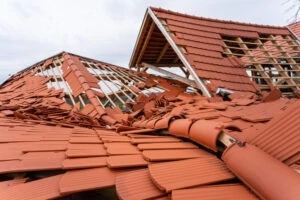
When a hurricane strikes, it can leave behind devastating damage, especially to your home’s roof or ceiling. A sudden collapse not only threatens your safety but can also create chaos, confusion, and costly repairs.
Knowing what steps to take in the aftermath can make all the difference. In this guide, our Corpus Christi hurricane damage claim lawyers will walk you through exactly how to deal with a roof or ceiling collapse after a hurricane, from ensuring your safety to filing an insurance claim and getting the legal help you may need.
Immediate Steps to Take After a Collapse
There are a few things you need to do as soon as possible after your roof or ceiling collapses:
Ensure Everyone’s Safety
Your first and most critical priority is getting everyone out of harm’s way. Roof or ceiling collapses can lead to serious injuries from falling debris, structural instability, or electrical hazards.
- Evacuate Immediately: If the collapse is active or just occurred, do not attempt to assess the damage. Quickly and calmly exit the affected area. Help children, pets, elderly individuals, or anyone with mobility issues to safety.
- Avoid Compromised Structures: Even if only part of the ceiling or roof has collapsed, the surrounding structure may also be unstable. Avoid hallways or rooms adjacent to the damage.
- Turn Off Utilities (If Safe): If you can do so without putting yourself at risk, shut off the electricity and gas. This prevents electrical fires or gas leaks, especially if water has infiltrated the space.
- Watch for Secondary Hazards: Look out for exposed wires, hanging drywall or beams, flooded areas with potential for electrocution, mold or dust that may cause respiratory irritation, etc.
Call Emergency Services (If Necessary)
Some roof collapses may seem manageable at first, but others can pose serious threats that require immediate professional intervention. Knowing when to call emergency services could save lives and prevent further destruction. Consider contacting 911 if any of the following situations apply:
- Someone is injured or trapped.
- You suspect gas leaks or smell gas.
- There’s visible sparking, smoke, or fire risk.
- The collapse affects multiple parts of the house or threatens structural integrity.
Wait for first responders outside. Let them do a safety assessment before re-entering your home.
Protect Yourself from Further Injury
If you are unable to evacuate the home, follow these precautions:
- Block Off the Area: Use caution tape, furniture, or signs to keep people from entering the damaged zone.
- Do Not Attempt DIY Repairs Right Away: Until the structure is assessed by a professional, don’t try to remove ceiling panels or patch holes. You could make the damage worse or injure yourself.
- Wear Protective Gear: If entering the area briefly to gather essentials, wear gloves, closed-toed shoes or boots, a mask (especially if insulation or mold is exposed), and eye protection.
We have offices in Houston, Corpus Christi, and Victoria; and will travel to any corner of Texas if we are capable of preventing an injustice.

Secure and Document the Damage
Once everyone is safe and any immediate danger has passed, the next crucial step is to preserve evidence and prevent further loss. Thorough documentation and basic damage control can make a significant difference in the insurance claim process and speed up repairs.
Take Photos and Videos Immediately
Insurance companies often require clear visual proof of the damage before any cleanup or repairs begin. The more comprehensive your evidence, the stronger your claim.
Tips for documentation:
- Wide shots: Take clear, well-lit pictures of the entire affected area, including the ceiling, floor, and surroundings.
- Close–ups: Zoom in on cracks, exposed beams, fallen insulation, soaked furniture, and broken roofing materials.
- Take photos from multiple angles: Stand in each corner of the room and take photos from different perspectives.
- Document hidden damage: If you can safely do so, capture signs of water stains, mold growth, sagging drywall, or collapsed attic spaces.
- Use timestamps: If your camera doesn’t timestamp by default, mention the date and time in a voice note or filename.
- Don’t clean up yet: As tempting as it may be, avoid throwing out debris or damaged property until an adjuster has seen it.
Make Temporary Repairs (If Safe to Do So)
You’re expected to prevent further damage to your home. Insurance policies usually require “reasonable efforts” to mitigate additional losses, even before your adjuster arrives.
Examples of temporary repairs you should make if safe:
- Placing a tarp over the roof to stop additional rainwater from getting in
- Placing plastic sheeting or boards over broken windows or skylights
- Using buckets or containers to catch drips from above
- Moving valuables and electronics out of the danger zone
Important Reminders:
- Keep all receipts: Keep all receipts for tarps, tape, tools, or contractor emergency work in a safe place; your insurer may reimburse these expenses.
- Do not attempt permanent fixes: Avoid nailing, replacing drywall, or discarding materials until directed by your insurer or a professional.
- Safety first: Never climb on a damaged roof or enter a room that may collapse further. Leave structural evaluation to professionals.
As soon as the area is documented and stabilized, your next move should be notifying your insurer. Reporting quickly often improves your chances of receiving emergency funding for repairs and temporary housing.
Notify Your Homeowners Insurance Provider
After securing your home and documenting the damage, your next priority is to contact your homeowners’ insurance provider as soon as possible. Acting quickly and with thorough documentation can significantly improve your chances of receiving a fair and timely payout.
File a Claim Promptly
Most insurance policies have strict time limits for reporting hurricane-related damage. Delaying your claim could result in reduced coverage or denial.
Call your insurer or file online through their website or mobile app. Explain the situation clearly. Indicate that the damage is the result of a hurricane and specify that the roof or ceiling has collapsed. When you file, provide:
- Photos and videos of the damage
- A brief written timeline (when the collapse happened, when you discovered it, and any immediate actions you took)
- A list of damaged personal property
Ask about emergency repair coverage. Many policies include additional living expenses (ALE) and emergency mitigation allowances to help cover:
- Temporary housing or hotel stays
- Food or relocation expenses
- Tarping, boarding, or water removal services
Be sure to get a claim number and the name of your assigned adjuster. Keep all communication in writing when possible, or follow up phone calls with email summaries.
Understand Your Policy Limits
After a hurricane, understanding what your policy does and doesn’t cover can help you plan next steps and avoid surprises. For example, some locations require specific types of insurance that others do not, according to the Texas Department of Insurance. Some insurance policies don’t cover certain types of damage.
It is imperative that you understand what your policy covers to protect you from insurance companies that claim your losses aren’t covered. Our team can help you ensure you understand your coverage and protect you from bad faith practices.
Representing the injured in all areas of Texas that extends back over 40 years

If You Are Facing Difficulties or Bad Faith, Give Our Team a Call
A roof or ceiling collapse after a hurricane is overwhelming, but you don’t have to face it alone. While acting quickly and documenting everything is essential, insurance companies don’t always make the process easy.
If your claim is delayed, denied, or underpaid, don’t hesitate to contact our Corpus Christi insurance claims lawyers. We can protect your rights, negotiate on your behalf, and help you get the compensation you deserve.
Call Carrigan & Anderson, PLLC, today.
At Carrigan & Anderson, PLLC we can talk to you about your options and rights.


